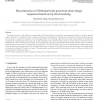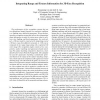198 search results - page 30 / 40 » A hierarchical model for syllable recognition |
110
click to vote
ABIALS
2008
Springer
15 years 6 months ago
2008
Springer
Anticipation and prediction have been identified as key functions of many brain areas facilitating recognition, perception, and planning. In this chapter we present a hierarchical ...
131
click to vote
PR
2007
14 years 12 months ago
2007
This paper presents a novel method for reconstructing a 3D human body pose from stereo image sequences based on a top-down learning method. However, it is inefficient to build a ...
106
Voted
NN
2008
Springer
15 years 9 days ago
2008
Springer
Learning data representations is a fundamental challenge in modeling neural processes and plays an important role in applications such as object recognition. In multi-stage Optima...
102
click to vote
AAAI
2010
15 years 1 months ago
2010
Multi-Agent Plan Recognition (MAPR) seeks to identify the dynamic team structures and team behaviors from the observations of the activity-sequences of a set of intelligent agents...
112
click to vote
WACV
2005
IEEE
15 years 6 months ago
2005
IEEE
The performance of face recognition systems that use two-dimensional images depends on consistent conditions w.r.t. lighting, pose, and facial appearance. We are developing a face...


